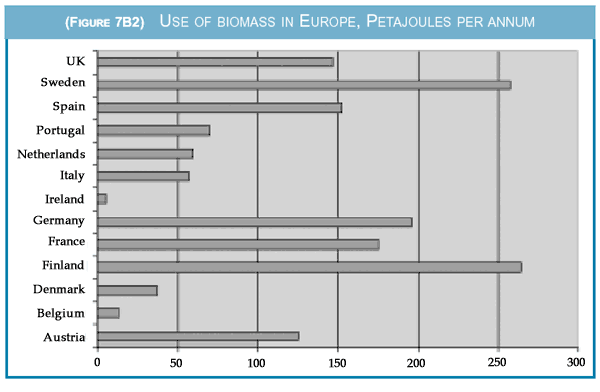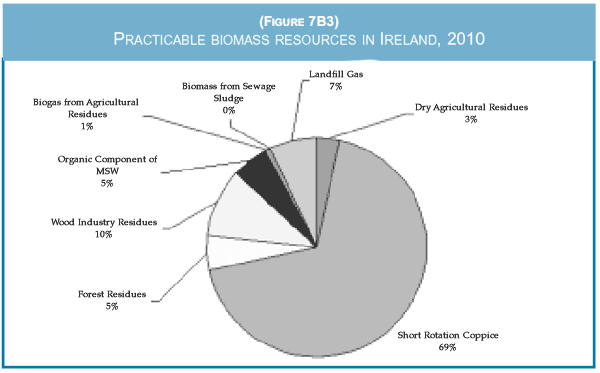

Ireland is one of Europe's laggards in developing its bioenergy resources,
despite their versatility. One reason for this is that no single government
department has accepted responsibility.
Plants convert sunlight into plant matter (biomass),
which is stored energy. This energy can
be released for our use with the right technology.
Biomass can be sourced from a wide range
of materials as outlined in the table below.
1.0 BIOMASS AND BIOENERGY
TECHNOLOGIES
1.1 SOURCES OF BIOMASS

There are a range of technologies which can then be utilised to produce energy from these biomass sources. This energy (bioenergy) can be in the form of heat, electricity or transport fuels. This is a vitally important factor given the fact that the Total Primary Energy Requirement (TPER) for Ireland can be equally divided between electricity, heat and transport fuel usage. Bioenergy is the only renewable energy which can meet all parts of the 'energy pie.'
A number of technologies can be utilised to capture the energy in biomass sources. Only a brief comment on each technology is provided here as it is not within the scope of this paper to describe each technology in detail. More information on these can be supplied by the Irish Bioenergy Association if required.
This is a process where organic material is placed in a sealed vessel or tank in the absence of air (anaerobic) and bacteria work on the material. It is broken down and the resulting reaction releases methane gas, which is then captured and can be utilised in a boiler or combined heat and power (CHP) plant. AD plants can range in scale from individual farm-based units to large centralised units taking material from a range of sources. AD is growing dramatically in Germany and other EU countries.
This is a well known technology generally but modern systems and equipment which are fuelled by wood and other biomass sources are new to Ireland. Systems are available to suit all sectors from domestic to industrial and these are well proven in other European countries.
This is still a developing technology. It differs from combustion in that, when dealing with wood in particular, a gas is produced from the fuel by controlling the air intake, and the temperature and pressure within the gasification chamber. This gas can then be utilised in an engine or a turbine, linked to a generator, to produce heat and electricity. Gasification has particular opportunities when seeking to develop small scale CHP projects (<1MW).
The next step on from gasification is pyrolysis where instead of a gas an oil can be produced from the biomass material. This technology is still very much as the development stage and there is little work ongoing in Ireland at present.
Energy crops and waste materials (such as vegetable oils and tallow) which can be used to produce transport fuels will come more and more into focus in the immediate future. This will be driven by the increasing cost of traditional transport fuels (petrol and diesel) and the need to comply with an EU Directive on Biofuels. The production of these fuels is well proven in other EU countries and it is generally accepted that market development is dependent not on technical breakthroughs but on financial supports such a reduced excise duty on biofuels.
Given the diverse nature of the biomass sector and the need for a range of actors and interested bodies to co-ordinate efforts a group of people came together in 1998 to form the Irish Bioenergy Association (IrBEA). The Association's mission statement is:
The Irish Bioenergy Association (IrBEA) is an organisation which seeks to maximise the use of bioenergy and the awareness of its benefits on the island of Ireland. This will be achieved by influencing Government policy and public opinion, project facilitation and the provision of support to existing and potential bio-energy users and producers.
Its key visions are that:
Its key activities are in the following areas:
IrBEA is also affiliated to AEBIOM, the European Biomass Association.
At a European level biomass has achieved a
considerable share of the energy market. Figure
7B2 (Kellett, 2002) illustrates the annual use of
biomass across Europe. It is evident from this
picture that Ireland is lagging significantly
behind in its exploitation of the resources outlined
in Section 1.

 |
If the potential is there and bioenergy can meet a number of different market needs (electricity, heat and transport) then there must be barriers which are restricting development. These barriers have been summarised in a number of key categories:
As noted, biomass can be obtained from a number of sources and also can meet the requirements of different sectors e.g. waste management, climate change, enterprise development, alternative agricultural enterprises. As a result it is often difficult to find, particularly at government level, a department which can take control of bioenergy development. This 'control' is important as without it both policies and financial support cannot be maximised.
There are multiple policies at international, European and national level which have an impact on the development of bioenergy. These include the Kyoto Protocol, EU directives on electricity from renewable energy and biofuels, waste management and water quality Directives and the Irish National Climate Change Strategy and Green Paper on Sustainable Energy. Unless these policies are integrated, barriers to development can be 'unwittingly' put in place. However, through integration and synergy it may be possible to maximise the development of the resource. This requires communication and dialogue, in particular at a national level.
While the majority of technologies have been well proven in other EU countries they are still new to Ireland. There are few demonstration plants and a lack of markets and supply systems for fuels. Indeed, access to finance at reasonable rates is a particular issue given the perceived level of risk. In addition, there is a continued need for information and awareness creation in the whole bioenergy area.
Bioenergy projects can vary significantly in scale and the drive for larger (>3MW) renewable energy projects which has occurred generally under the Alternative Energy Requirement (AER) programme in Ireland does not always suit bioenergy projects. In addition, the effective utilisation of the heat produced from the bioenergy plant can significantly increase the financial viability but having a use for the heat is not always possible. Small scale plants could be developed across Ireland if the issues of grid connection costs and technology are addressed.
To date the support mechanism of the AER process has concentrated solely on electricity production. There is a need to support and develop projects which are heat only or CHP based. In addition, the support and development of the biofuels industry is vital, in light of the biofuels directive from the EU.
To overcome these barriers there are a number of policy and technical issues which can be addressed in the short to medium term, including:
Small scale projects often cannot carry the cost of grid connection. Net-metering or similar mechanisms need to be developed to facilitate smaller scale projects (<1MW).
While IrBEA accepts that the wind energy industry has developed significantly in the past five years, a significant problem exists with regard to the availability (percentage of time electricity is actually exported to the grid) of wind energy to the grid (typical values of between 30-40%). Most bioenergy projects which generate electricity have availabilities in the region of 90%. This is of vital importance when addressing such issues as power quality and meeting peak demand.
The AER process has failed to develop bioenergy apart from landfill gas sites. There is an urgent need to revise this approach and develop a new mechanism which can support the multiple benefits of bioenergy and therefore support project development in other sectors.
Currently 1% of Ireland's TPER comes from wood fuel (used domestically and in the wood processing industry). This can be increased and systems exist for the domestic and commercial sector but these are capital intensive compared to traditional fossil fuel based heating systems. Support is required, perhaps modelled on the UK grant and installer accreditation system.
This can be done with immediate effect. The mechanism which was in place under a previous Finance Bill was not properly advertised and supported. The industry is now better placed to utilise such a support mechanism.
The SEI Renewable Energy RD&D Programme should address this issue partly but more supports will be needed in the future.
Data and information from demonstration projects must be made available to the industry to allow it to improve and modify applications to Irish conditions. This must be coupled with the provision of quality technical information and support structures.
The need for these has been highlighted above and can only be addressed through the relevant government departments.
While demonstration plants and projects can be established it is vital that the fuel supply systems are also supported. Systems for the supply of fuels to wood or anaerobic digestion (AD) plants need to be developed and proven economically.
The development of the practical bioenergy resource in Ireland is a challenge which will take considerable effort to achieve. Developing the industry can meet a range of policy targets and solve a number of problems. There are opportunities for some 'quick wins' but support mechanisms are needed if these are to be achieved.
Given that the technology has been proven in many other EU countries, many of the current barriers are non-technical and relate to financial and infrastructural issues. A co-ordinated strategy, which engages the relevant government departments and other relevant bodies, can assist in moving the industry forward. Information and education of policy makers, financiers and potential project owners and developers is vital and an immediate need. For the industry to develop the existing and potential developers will need to lobby and this can be most effectively done through the Irish Bioenergy Association.
IrBEA (2002), Irish Bioenergy Association Strategic Plan.
Sustainable Energy Ireland (2002), Renewable Energy RD&D Programme Strategy, Dublin. Available from www.sei.ie
Kellett, P (2002), Introduction to Renewable Energy - Presentation to Certificate in Renewable Energy students, Tipperary Institute.
Irish Bioenergy Association
This is one of almost 50
chapters and articles in the 336-page large format book, Before the Wells
Run Dry. Copies of the book are available for £9.95 from Green Books. Continue to part C of Section 7: Small hydro: the potential to grow but no incentive
c/o Tipperary Institute
Nenagh Rd, Thurles, Co. Tipperary
Tel: 0504 28105 Fax: 0504 28111
Email: khealion@tippinst.ie(Kevin Healion is Secretary of IrBEA for 2003)
Web:
